Cataracts in dogs are a common eye condition that can lead to partial or complete blindness in dogs if left untreated. Similar to humans, a cataract involves the clouding of the lens, obstructing light from reaching the retina and thus impairing vision.
Understanding cataracts, their causes, symptoms, treatment options, and preventive measures is crucial for pet owners to ensure their dog’s visual health.
This article will cover the causes of cataracts in dogs, diagnostic methods, treatment options for cataracts and blindness in dogs, and potential outcomes for affected dogs.
What is Cataract in Dogs and How It Can Lead to Blindness?
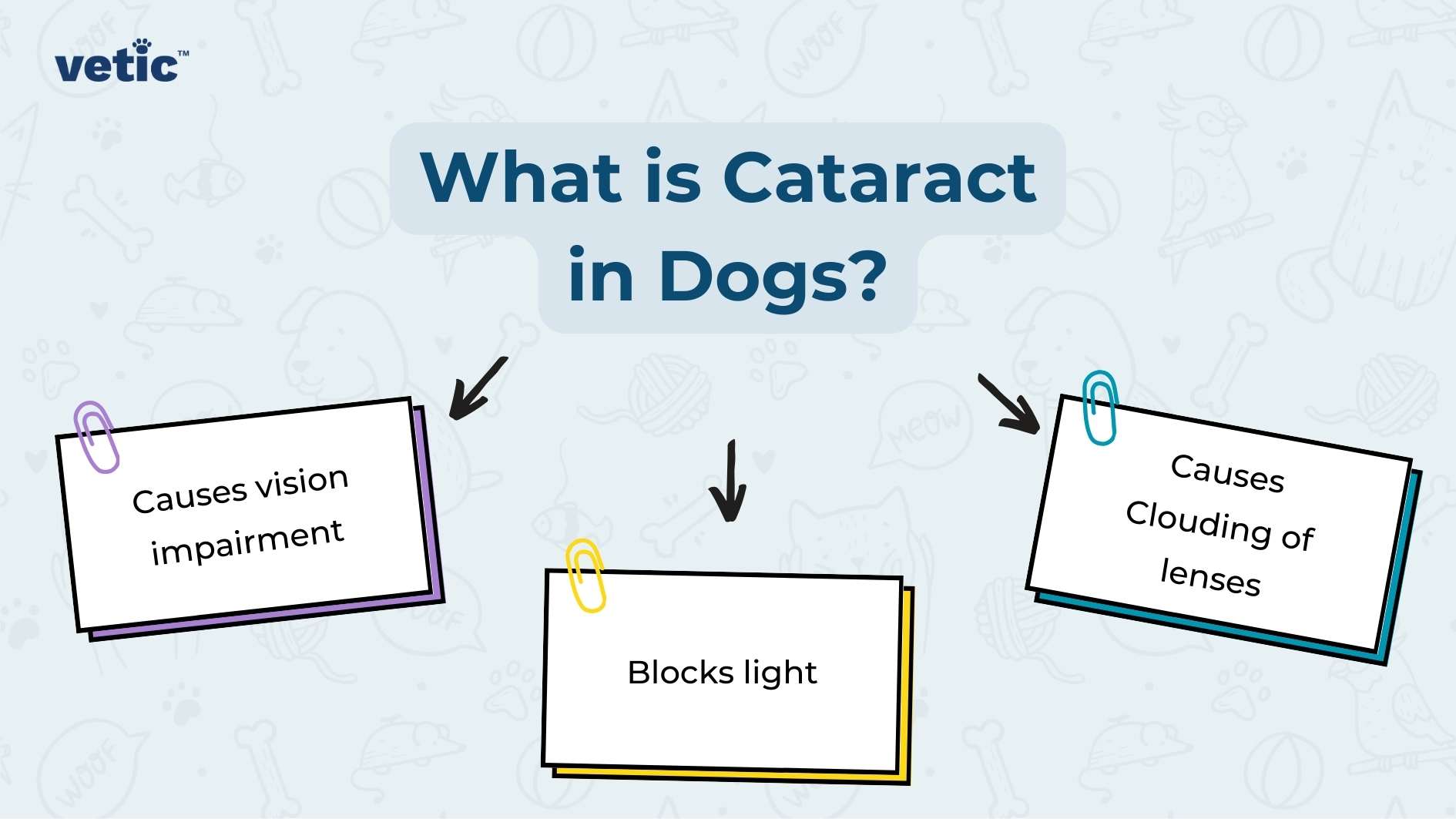
A cataract is an opacity or cloudiness that develops in the lens of the eye, which should normally be transparent.
In dogs, this cloudiness disrupts the passage of light to the retina, making it difficult for the eye to focus.
Over time, the cataract grows, obstructing vision and eventually leading to blindness. If untreated, cataracts can progress to cause total vision loss, especially if the lens completely loses transparency.
What is the Difference Between Cataract and Normal Aging Lens (Nuclear Sclerosis)?
Not all cloudy eyes in older dogs are cataracts. A common, harmless condition called nuclear sclerosis can also cause a bluish haze.
Here is a simple comparison:
| Feature | Cataract | Nuclear Sclerosis |
| Appearance | White or opaque cloudiness | Bluish-grey haze |
| Impact on Vision | Causes partial or total vision loss | Does NOT cause vision loss |
| Cause | Genetics, diabetes, aging, trauma | Natural age-related lens hardening |
| Treatment | Surgery | No treatment needed |
This is important for pet parents searching “dog cataract vs cloudy eyes” because not all cloudy eyes are dangerous.
What Causes Cataract in Dogs Leading to Blindness?
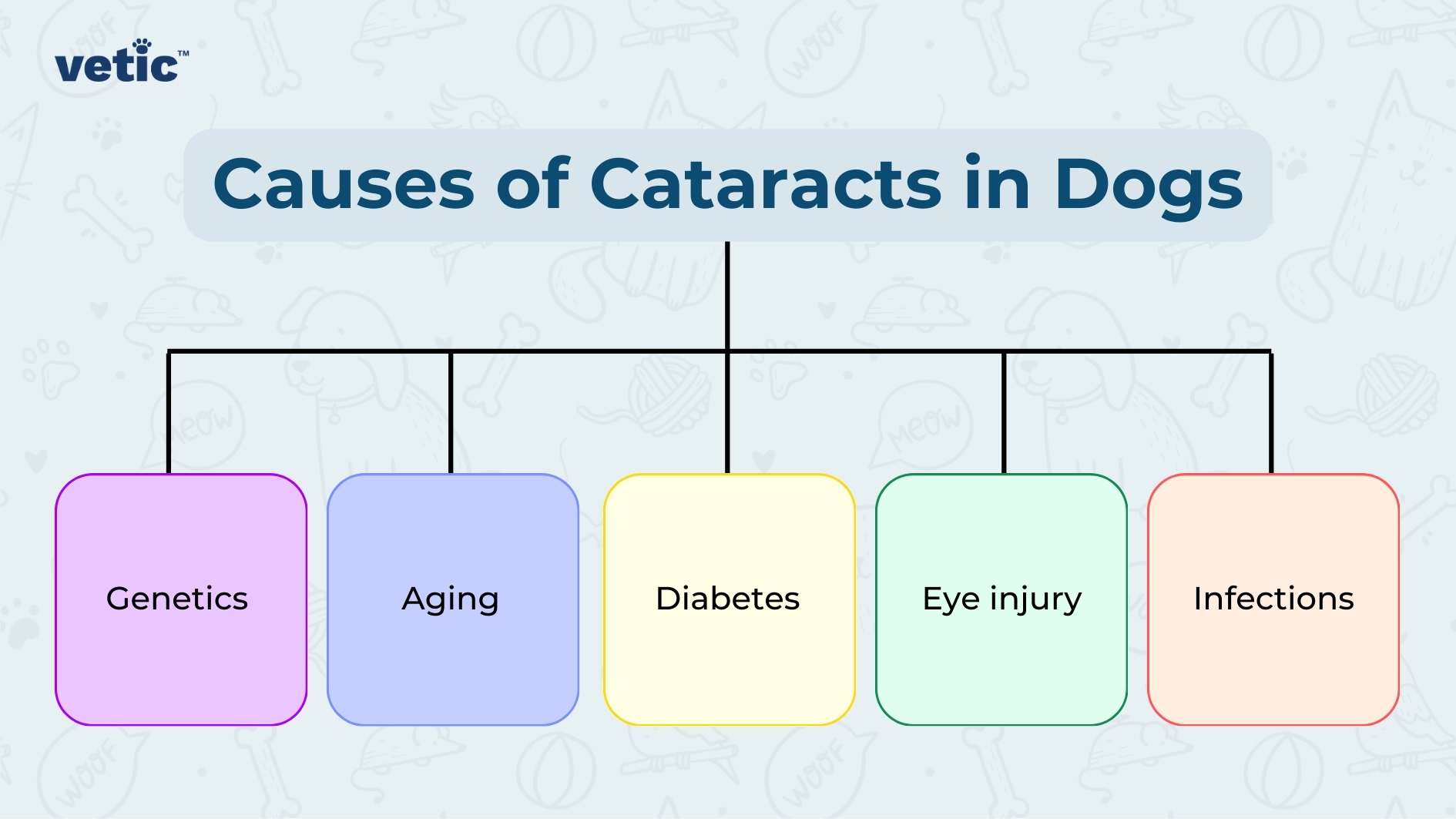
Cataracts can result from aging, genetics, diabetes, injuries, or chronic inflammation. These factors change the structure of the lens, causing it to turn white and opaque:
Do Genetic and Congenital Factors Contribute to Cataracts?
Some cataracts are inherited and may appear early in life. Hereditary cataracts in dogs are more common in some breeds, including:
- Cocker Spaniels
- Poodles
- Golden Retrievers
- Siberian Huskies
- Boston Terriers
How do Age-Related Cataracts Causes Lens Degeneration?
As dogs grow older, proteins inside the lens naturally break down. With time, these changes can cause the lens to lose its transparency.
This is why lens degeneration and age-related cataracts are common in senior dogs.
Can Elevated Blood Sugar Lead to Diabetes-Induced Cataracts?
Diabetes in dogs increases risk of rapidly developing cataracts. High blood sugar alters the chemical structure of the lens, causing it to swell and turn cloudy, sometimes within days or weeks.
To know more about how diabetes affects your dog’s eyes, you can also check our guide on Diabetes in Dogs: Signs and Management.
How Eye Injury or Inflammation (Uveitis) Triggers Cataract Formation?
Eye trauma, infections, and chronic inflammation, such as uveitis, can also damage the lens. Untreated injuries or inflammation can trigger lens opacity and cataract formation.
If My Dog is Blind, Does it Mean They Have Cataracts?
Not all cases of blindness in dogs are due to cataracts. Blindness can result from other issues such as:
- Glaucoma
- Retinal degeneration or detachment
- Optic nerve disorders
- Severe trauma
To learn more, see our guide on Glaucoma in Dogs.
Therefore, while cataracts are a common cause of blindness in dogs, a thorough veterinary examination is needed to determine the exact cause of the blindness.
Does Cataract in Dogs Always Lead to Blindness?
Cataracts do not always lead to complete blindness. In the early dog cataract stages, it may only cause mild vision impairment. However, if left untreated, cataracts can:
- Block vision completely
- Cause inflammation
- Lead to glaucoma, a painful and dangerous complication
This progression may vary based on the dog’s age, overall health, and the underlying cause of the cataract. Early diagnosis and timely surgery can preserve your dog’s vision and prevent complete blindness.
Does My Dog Have Cataract: Signs of Cataract in Dogs?
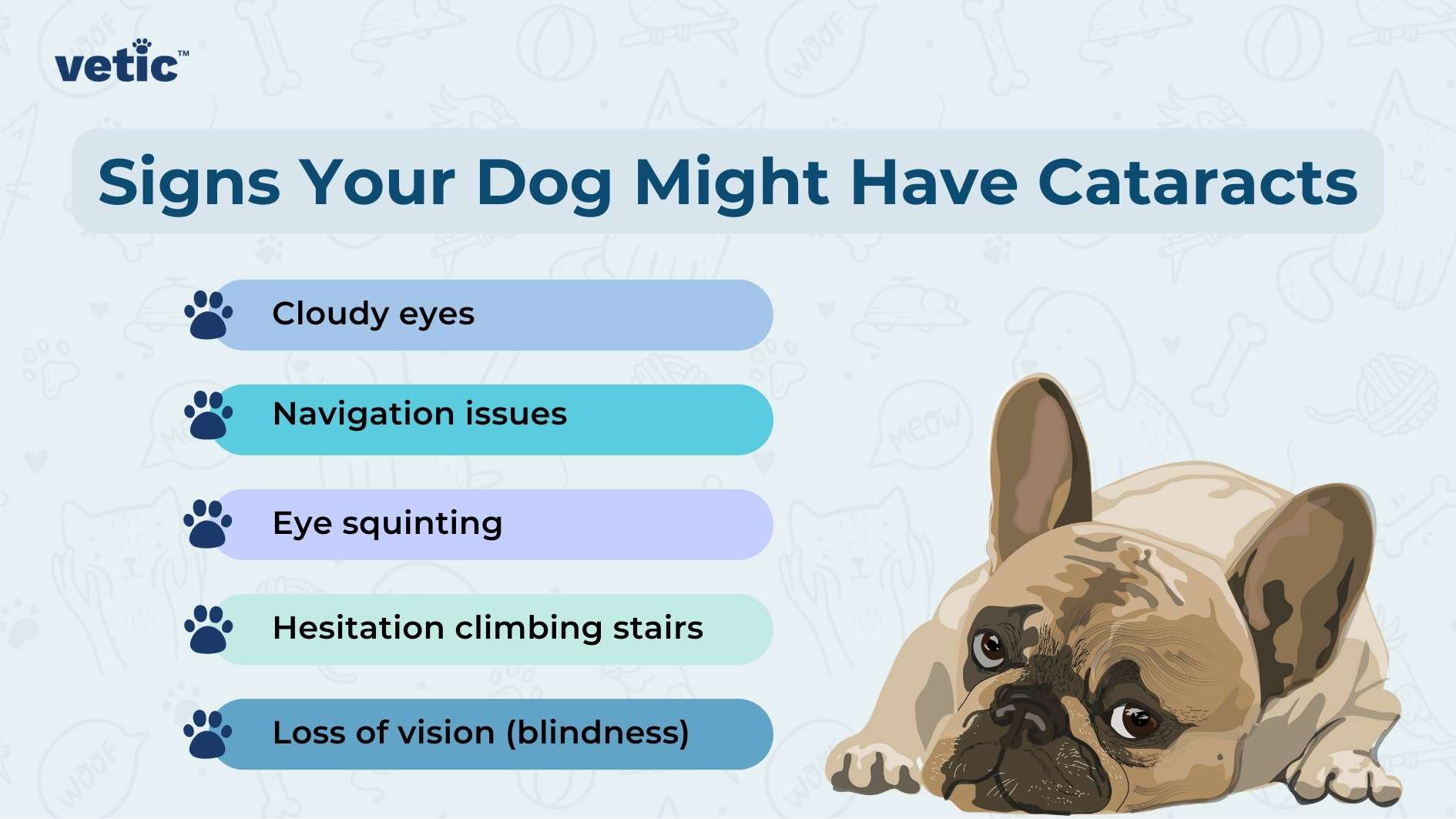
Dogs often show subtle visual changes before cataracts are visibly noticeable.
What are the Visible Signs of Cloudiness or Vision Changes?
Common physical signs of cataract in dogs include:
- Cloudy or white pupils
- Bluish-grey haze over the eye
- Redness or increased tearing
- Eye whiteness or visible opacity
These are common dog cataract symptoms pet parents notice first.
What are the Behavioral Changes That Indicate Vision Problems?
Dogs may show:
- Bumping into furniture
- Hesitation in dim light
- Difficulty locating toys
- Slower movement or cautious navigation
- Reluctance to jump or climb stairs
- Anxiety in new places due to reduced vision
- Increased squinting or pawing at the eyes
What Can I Do if My Dog Has Cataracts?
If you suspect your dog has cataracts, it’s important to take them to a veterinarian for a comprehensive eye examination. Early evaluation helps determine the cause and whether surgery is needed.
How to Diagnose Cataracts in Dogs?
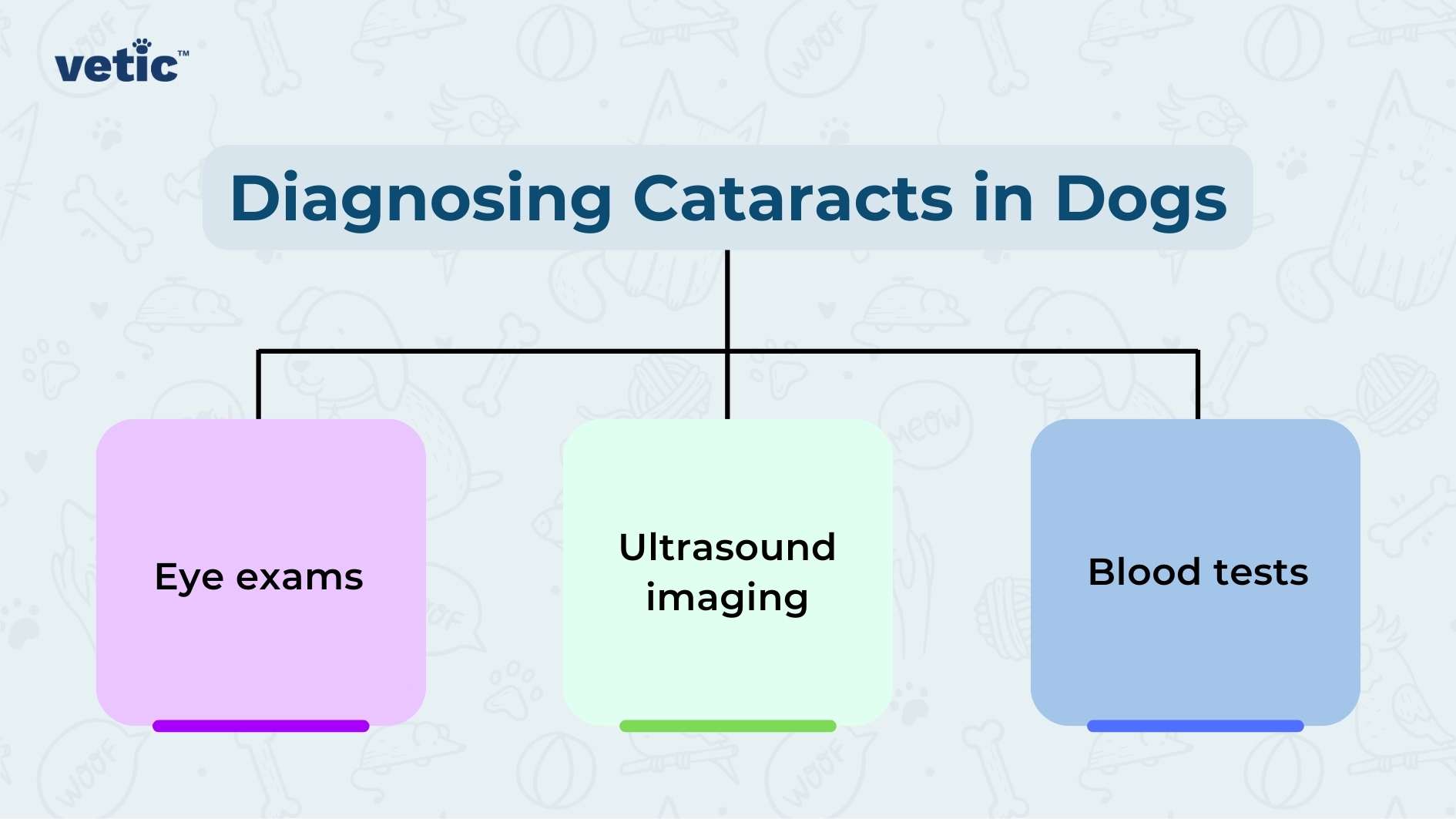
Your veterinarian may perform several tests, including:
- Ophthalmic exam: This involves examining the lens and retina using specialised instruments.
- Ultrasound imaging: In cases where the cataract is advanced, ultrasound may be used to check the health of the retina behind the cloudy lens.
- Blood tests: Common blood tests may be performed to check for underlying conditions such as diabetes, which can contribute to cataract formation.
- Slit-lamp evaluation: A microscope-based exam to closely assess the lens and confirm cataract severity.
- Retinal examination: A check to ensure the retina is healthy and responsive before planning treatment or surgery.
- Blood sugar check: Measures glucose levels to identify diabetes-related cataracts.
These dog cataract diagnosis tests help confirm the condition and determine the best treatment approach.
Why Pre-Surgery Eye Evaluation Is Essential?
Before considering surgery, the ophthalmologist assesses whether the retina is healthy enough to support vision after the cataract is removed.
A functional retina is essential for successful vision restoration.
Can Cataract in Dogs Be Operated Just Like Cataract in Humans?
Yes, cataract surgery in dogs is similar to that in humans. The procedure is performed under general anaesthesia by a veterinary ophthalmologist.
However, surgery for cataract in dogs is rare in India. Speak with your veterinary doctor to learn about the clinics and hospitals in your area that perform this surgery.
What are the Treatment Options of Cataracts in Dogs?
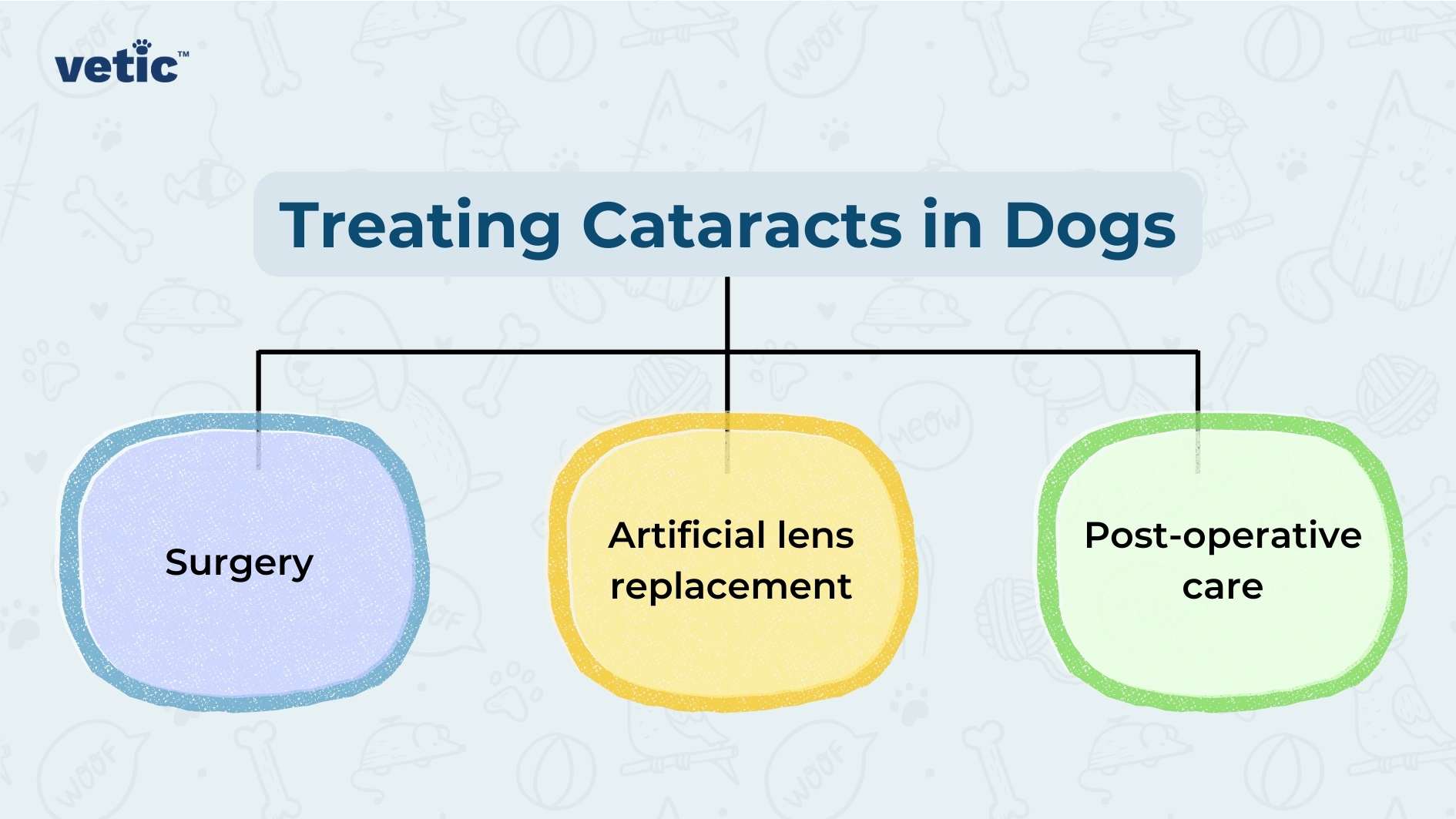
The primary treatment for cataracts is surgical removal of the cloudy lens, which is replaced with an artificial lens. Cataract surgery (phacoemulsification) is the only permanent solution; it removes the cloudy lens and replaces it with an artificial intraocular lens to restore focused vision.
There are no medications that can reverse cataracts.
If left untreated, cataracts can lead to complications like lens luxation (displacement) or glaucoma. Timely intervention, particularly surgery, can prevent blindness and restore vision in many cases.
What are the Cataract Surgery Options for Vision Restoration?
- The operation is performed by a veterinary ophthalmologist under general anesthesia.
- The most commonly used technique is phacoemulsification, where an ultrasonic probe breaks up the cloudy lens, which is then removed and usually replaced with an artificial lens (IOL).
- Many dogs show rapid improvement in vision within days, with functional vision often returning quickly when the retina is healthy.
- Suitability for surgery depends on pre-surgical tests that assess retinal health and overall fitness for anesthesia.
These evaluations are also important for estimating the dog cataract surgery cost in India, since the final expense depends on the surgical method, diagnostic tests, and your dog’s overall health.
What are the Post-Surgery Recovery Tips and Aftercare Guidelines?
Post-operative care is crucial:
- Use prescribed eye drops consistently
- Keep the Elizabethan collar on
- Avoid rough play, running, or jumping
- Attend all follow-up visits
Following these steps helps prevent complications and ensures a smooth recovery.
How do Non-Surgical Management and Supportive Treatments Help?
For dogs who cannot undergo surgery, supportive care may help. Here are some options for dog cataracts treatment without surgery:
- Antioxidant supplements
- Anti-inflammatory eye drops
- Regular eye monitoring
These do not reverse cataracts but may slow progression or ease discomfort.
My Dog’s Blind From Cataract Development. Can Their Vision Be Restored?
In many cases, yes.
Dog vision restoration after cataract surgery is possible for most cases if the retina is healthy.
However, if the cataract is too advanced or has led to complications such as retinal detachment, only partial vision recovery may be possible.
A veterinary ophthalmologist will evaluate whether surgery is a viable option based on the dog’s overall health and the condition of the retina.
Is it Possible to Prevent Cataracts in Dogs? How?
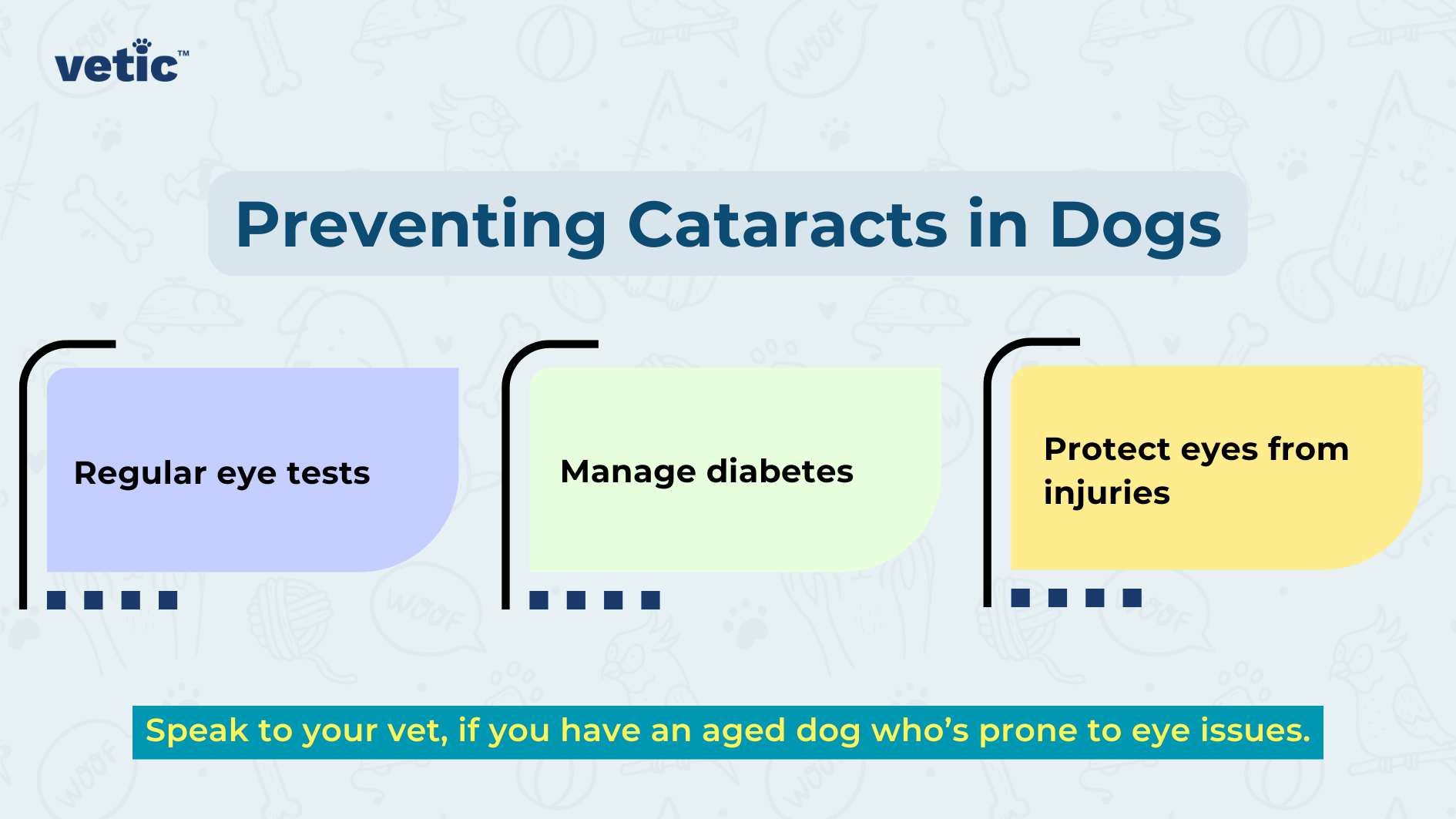
While some factors leading to cataracts, such as genetics and ageing, cannot be prevented, there are steps that can reduce the risk of cataracts:
- Control underlying conditions: Proper management of diabetes and regular veterinary check-ups can help delay cataract formation.
- Protect the eyes: Prevent eye injuries and infections, which can lead to cataracts.
Why Regular Eye Screenings for Early Detection and Care is Vital?
Senior dogs and diabetic dogs should have annual or biannual eye exams.
Early detection improves dog cataract treatment outcomes.
Book an eye health check-up at Vetic
Can Diet and Supplements Reduce Cataract Risk in Dogs?
Nutrients that support eye health include:
- Lutein
- Vitamin C
- Vitamin E
- Omega-3 fatty acids
- balanced diet with antioxidants
These nutrients support overall lens and retinal health and are commonly associated with a dog eye health diet.
If My Dog Recovers From Cataracts, How Long Will It Take to Heal?
After cataract surgery, recovery varies, but most dogs show:
- Initial improvement in 1–2 weeks
- Full recovery in 6–8 weeks
During this time, the dog may need to wear a protective collar to prevent rubbing the eyes.
Follow-up visits are necessary to monitor healing, and medicated eye drops are typically prescribed to reduce inflammation and prevent infection.
What are Some Essential Care Tips for Dogs Recovering From Cataracts?
- Give medications on schedule
- Prevent eye rubbing
- Monitor for redness or swelling
- Attend follow-up visits
- If you suspect any abnormal signs, seek immediate vet evaluation to confirm the diagnosis and prevent complications.
Book a same-day ophthalmology appointment with Vetic
What is the Cost of Cataract Surgery in Dogs in India?
The cost of cataract surgery in India typically ranges between:
₹30,000 to ₹80,000 per eye,
depending on:
- The clinic and city
- Severity of the cataract
- Pre-surgical tests required
- Post-surgery medications
This range helps pet parents searching for dog cataract surgery prices in India understand what to expect.
What Care Do I Need to Take if My Dog Has Cataracts?
If your dog has been diagnosed with cataracts, here are some steps you can take to support their vision and overall eye health:
- Regular vet visits: Ensure regular check-ups to monitor the progression of the cataract.
- Protect their eyes: Use protective eyewear or keep your dog in safe environments to avoid injury.
- Post-surgery care: Follow your veterinarian’s instructions carefully if your dog undergoes cataract surgery, including administering prescribed medications and attending follow-up appointments.
Cataract in Dogs and Blindness: Takeaway
Cataracts are a common eye condition in dogs that can lead to blindness if not treated. Early diagnosis, proper care, and timely surgical intervention can significantly improve the quality of life for dogs with cataracts. While some dogs may never experience full blindness from cataracts, others may benefit greatly from surgery. Regular eye check-ups make a significant difference. Managing diabetes and maintaining a healthy diet can reduce cataract risk. Preventive measures, such as managing underlying conditions and protecting the eyes from injury and UV exposure, can help reduce the risk of cataract development.
Download the Vetic App to set reminders for your pet’s follow-ups
FAQs on Cataracts in Dogs and Blindness
1. What is cataract in dogs?
Cataracts are cloudy changes in the lens that block light and impair vision.
2. What are the early symptoms of cataracts in dogs?
Cloudy eyes, bumping into objects, and hesitation in low light.
3. What causes cataracts and blindness in dogs?
Cataracts in dogs can be caused by genetics, aging, diabetes, eye injuries, or chronic eye inflammation.
4. How is cataract in dogs diagnosed by veterinarians?
Through ophthalmic exams, retinal evaluation, blood tests, and imaging.
5. Can cataracts cause total blindness in dogs?
Yes, if left untreated, cataracts can cause total blindness in dogs.
6. What are the available treatments for cataracts in dogs?
Surgery is the only permanent treatment, where the cloudy lens is removed and replaced with an artificial one.
7. Is cataract surgery safe and successful in dogs?
Yes, when performed by trained veterinary ophthalmologists.
8. Can cataracts in dogs be prevented through diet or care?
A healthy diet, supplements, and regular eye exams help reduce risk.
9. How can I take care of a dog that has become blind?
Maintain a safe environment, use verbal cues, and keep routines consistent.
10. Are certain dog breeds more prone to cataracts and blindness?
Yes. Cocker Spaniels, Poodles, Golden Retrievers, and Huskies are at higher risk.

